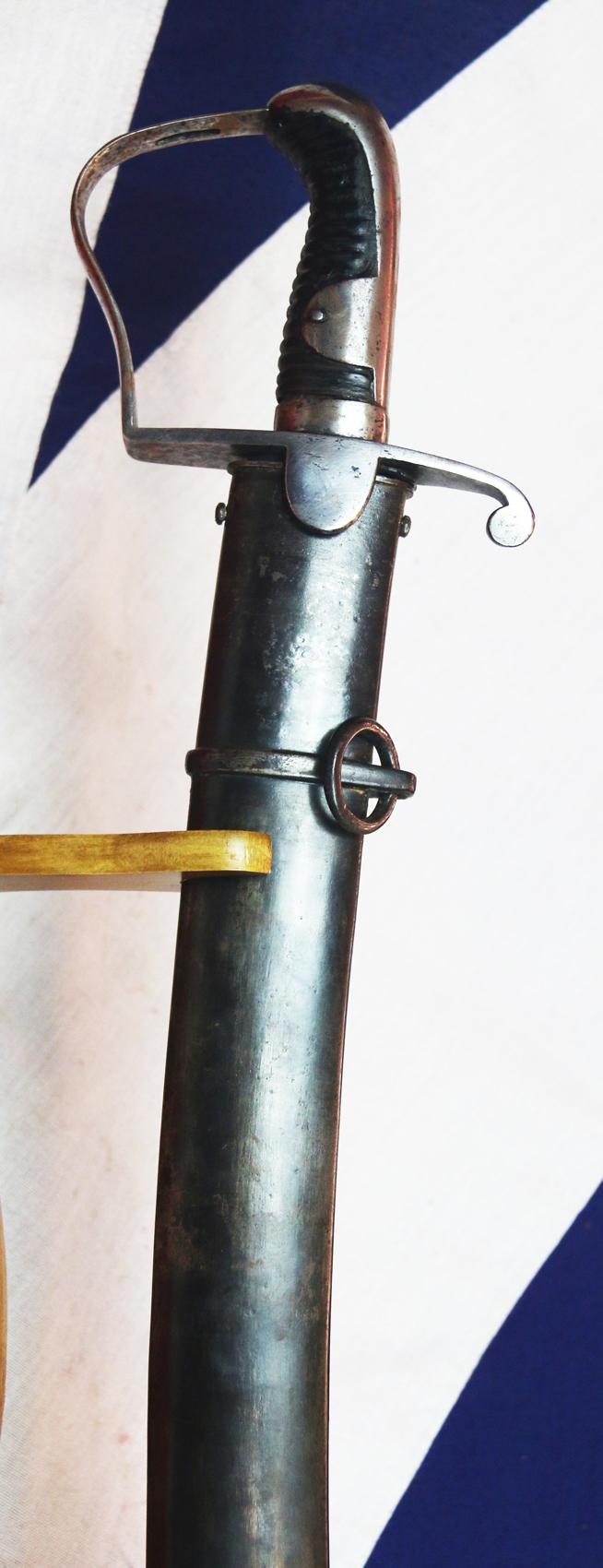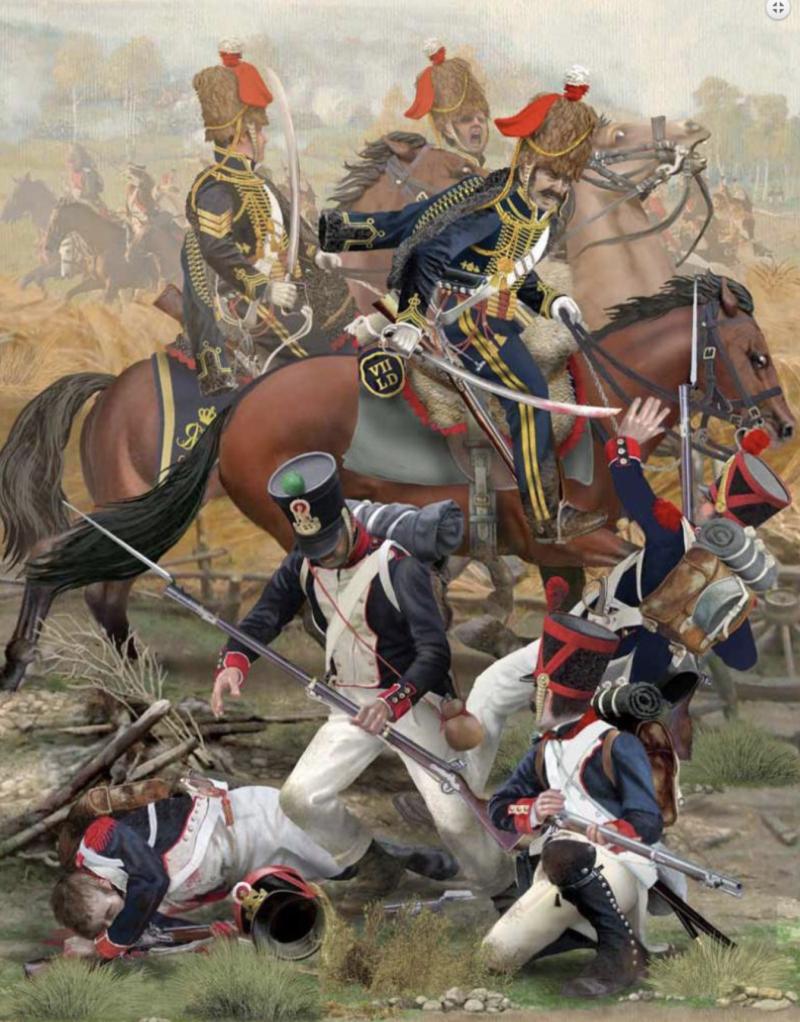An Excellent 1796 Napoleonic Wars British Light Dragoon Trooper's Sword, In Exceptional Condition, A Regiment of the Line Issue Combat Sabre, For An NCO Or Other Rank Trooper
All steel blued scabbard, with bright steel P hilt and leather bound grip. The blade is very good indeed, and nicely bright overall, made circa 1802 to 1803. All the steel mounts have excellent patina. Overall very nice condition for age, obviously seen combat service but it has been cared for very well since it left service over 200 years ago. Maker stamped by {Samuel} Dawes, ordnance contract maker of 1796 pattern light and heavy dragoon trooper's swords, a maker in Birmingham, 1797 to 1803, & ordnance inspector stamped on the blade face, Crown over 11.
This sword would have been used by a Light Dragoon trooper in any of the light cavalry regiments of the line, of the Napoleonic Wars, such as one who served, just for example, in the 11th Light Dragoons.
The 11th Light Dragoons later became the 11th Hussars. The 11th fought at both the Peninsular War and at the Battle of Waterloo, and were awarded almost 500 medals for Waterloo. After a spell in Ireland the 11th were sent to Spain and Portugal to reinforce Wellington's army. Their strength, normally around 300 in peacetime was raised to 725. They arrived in June 1811 and, as in Egypt, they had a bad start. A dawn attack by the French in woods between Elvas and the Guadiana forced the 11th to retire on to what they thought were friendly Portugese lines. When they realised they were French, their commander Capt Lutyens ordered the charge. The shock tactic worked and they were able to drive their way through, but a second line of enemy troops was able to resist them. They lost 8 killed, 22 wounded and 77 taken prisoner.
The regiment had more success at El Bodon near Cuidad Rodrigo on 25th September. By this time they were commanded by Lt Col Cumming, a brave and efficient cavalry officer. A large force of French cavalry was threatening Allied infantry and artillery on the plain in front of the 11th and a squadron of the King's German Legion who were well placed on high ground. Although they were vastly outnumbered the 11th and KGL charged at the enemy again and again, 20 times in all.
The 11th were part of Wellington's great victory over Marmont at Salamanca on 22nd July 1812 but by 3rd April 1813 they had to give up their horses and embark for England much to the regret of Sir Stapleton Cotton who was in command of the cavalry in the Peninsula. It had been a hard two years for them having lost 417 men and 555 horses.
During their time in the Peninsula many changes had been made to the uniforms of the British Army. The Prince Regent had a keen eye for dress and with his newly acquired position of supreme power was determined to push through his ideas based on continental military trends. The 11th exchanged it's light dragoon Tarleton helmet for a shako. The new jacket was still dark blue but had a buff plastron covering the chest, and white epaulettes, silver for officers. With the return of Napoleon in March 1815 the war with France resumed and the 11th arrived at Ostend on 2nd April. They were in Vandeleur's brigade with the 12th and 16th and had an unprecedented strength of 947 men. They came under heavy attack at Quatre Bras but did not suffer badly. On the 18th June 1815 the Battle of Waterloo began after a terrible night of torrential rain. It was a frustrating morning for the British cavalry who had to stand and watch an infantry battle. Against Wellington's wishes, the heavy cavalry made a brilliant charge that was spoiled by it's failure to re-form. The 11th under the command of Lt Col Money were sent into action when it looked as if the enemy were breaking up. They broke a French infantry square and carried on with the pursuit of Napoleon’s fleeing soldiers.
Wellington entered Paris in triumph on 7th July escorted by the 11th and others. The regiment bivouacked on the Champs Elysees and became part of the army of occupation in France and Belgium. On 20th November they eventually arrived home after 3 years on the continent
The mounted swordsmanship training of the British emphasised the cut, at the face for maiming or killing, or at the arms to disable. This left masses of mutilated or disabled troops; the French, in contrast, favoured the thrust, which gave cleaner kills. A cut with the 1796 LC sabre was, however, perfectly capable of killing outright, as was recorded by George Farmer of the 11th Regiment of Light Dragoons, who was involved in a skirmish on the Guadiana River in 1811, during the Peninsular War:
"Just then a French officer stooping over the body of one of his countrymen, who dropped the instant on his horse's neck, delivered a thrust at poor Harry Wilson's body; and delivered it effectually. I firmly believe that Wilson died on the instant yet, though he felt the sword in its progress, he, with characteristic self-command, kept his eye on the enemy in his front; and, raising himself in his stirrups, let fall upon the Frenchman's head such a blow, that brass and skull parted before it, and the man's head was cloven asunder to the chin. It was the most tremendous blow I ever beheld struck; and both he who gave, and his opponent who received it, dropped dead together. The brass helmet was afterwards examined by order of a French officer, who, as well as myself, was astonished at the exploit; and the cut was found to be as clean as if the sword had gone through a turnip, not so much as a dint being left on either side of it" The blade is remembered today as one of the best of its time and has been described as the finest cutting sword ever manufactured in quantity.
This superb sabre in overall in excellent condition for age, and it fits beautifully snug in its original scabbard, it just has with average wear to the leather grip, little or no surface pitting throughout, just light discolouration, and the scabbard has no denting.
Every single item from The Lanes Armoury is accompanied by our unique Certificate of Authenticity. Part of our continued dedication to maintain the standards forged by us over the past 100 years of trading
Code: 25424
1300.00 GBP







